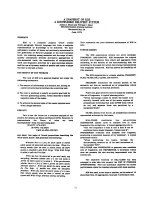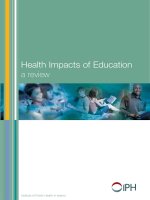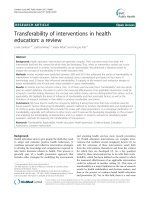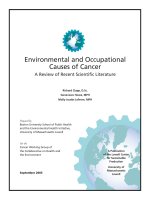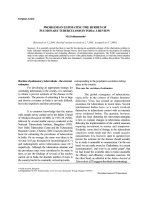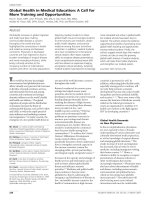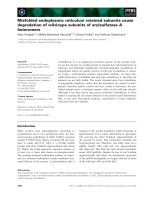Health Impacts of Education a review pot
Bạn đang xem bản rút gọn của tài liệu. Xem và tải ngay bản đầy đủ của tài liệu tại đây (484.48 KB, 38 trang )
Health Impacts of Education
a review
Institute of Public Health in Ireland
Health Impacts of Education
a review
Prepared by
Claire Higgins
Teresa Lavin
Owen Metcalfe
Institute of Public Health in Ireland
November 2008
2
Health Impacts of Education: a review
Published by the Institute of Public Health in Ireland
© The Institute of Public Health in Ireland, 2008
Reproduction authorised for non-commercial purposes provided the source is acknowledged
Prepared by Claire Higgins, Teresa Lavin and Owen Metcalfe
The Institute is very grateful to Áine Hyland (formerly UCC), Andy Pollak (Centre for Cross Border
Studies), readers in the Department of Education and Science, Republic of Ireland and the
Department of Education, Northern Ireland for reviewing a draft of this document.
ISBN 978-0-9559598-1-3
For further copies of this document please contact:
The Institute of Public Health in Ireland
5th Floor Forestview
Bishop’s Square Purdy’s Lane
Redmond’s Hill Belfast
Dublin 2 BT8 7ZX
Tel: +353 1 478 6300 Tel: +44 2890 64 84 94
Fax: +353 1 478 6319 Fax: +44 2890 64 66 04
Email:
www.publichealth.ie
3
Foreword 4
1: Introduction 5
1.1 A shared responsibility for health 5
1.2 Education as a social determinant of health 5
1.3 Inequalities in education and health 5
1.4 Research methodology 6
1.5 Diagram showing links between education and health 6
2: How education influences health 7
2.1 Health outcomes associated with education 7
Education, mortality and morbidity 7
Education and health behaviours 8
Education and health knowledge 10
Parental education and child health 10
2.2 Routes to health through education 11
Employment 11
Social behaviours and attitudes 12
Personal behaviours and attitudes 12
2.3 Supporting healthy behaviours and attitudes in the school environment 13
3: Education and health in Ireland 16
3.1 Educational outcomes 16
Overall increases in education 16
Poor literacy and numeracy skills 17
Early school leavers 18
Socioeconomic status 18
Gender differences 20
Ethnicity and cultural background 21
3.2 Targeting educational disadvantage 21
Pre-school 22
First and second level 23
Third level 23
Adult education 24
4: Conclusion 25
4.1 Addressing inequality 25
4.2 A lifecourse perspective 26
4.3 Cross jurisdictional learning 27
4.4 Cooperation between education and health 27
Appendix: Education systems in Ireland 28
Republic of Ireland 28
Northern Ireland 28
References 30
contents
4
Foreword
The Institute of Public Health in Ireland (IPH) was established to promote
cooperation for public health across the island of Ireland. It aims to improve health
by working to combat health inequalities and influence public policy in favour of
health.
One of the objectives of IPH is to provide clearly interpretable, easily accessible
information on public health. In recognition that health is determined by social,
economic and environmental circumstances, IPH has previously produced review
documents focusing on the health impacts of transport, the health impacts of
employment and the health impacts of the built environment. This review is the
fourth in the series and illustrates how education impacts on health.
It shows how education influences health through a range of interconnecting
pathways and identifies the ways in which social, economic and cultural
differences within the population impact on the experience of and outcomes from
education with subsequent implications for health.
This document is aimed at a wide audience, including policy-makers and
practitioners in health and education and those working in the community. We
hope it will help inform debate about the links between education and health and
be a useful resource for those working to influence public policy for health at local
and national level across the island.
Jane Wilde
Chief Executive
Institute of Public Health in Ireland
1. Introduction
1.1 A shared responsibility for health
People’s opportunities for health are strongly influenced by the social and
economic conditions in which they live. These opportunities are encapsulated in a
social determinants approach to health which recognises that a broad range of
factors at local, national and global level have important influences on health. As
most of these factors are outside the direct responsibility of the healthcare sector,
building greater awareness amongst the non-health sector of the impact of their
policies and practices on health is vital in working to create better health.
1,2
1.2 Education as a social determinant of health
Education is an important social determinant of health. For the population as a
whole, greater levels of education help to create wealthier economies. However
the benefits of education go far beyond economic ones. Education can impact
positively on levels of social engagement, an important factor in generating more
cohesive, safer and healthier societies. At an individual level, the knowledge,
personal and social skills provided through education can better equip individuals
to access and use information and services to maintain and improve their own and
their family’s health.
Improved understanding of the relationship between education and health will help
to identify where intervention is most appropriate and effective in improving both
individual and population health.
1.3 Inequalities in education and health
Access to and participation in the education system are prerequisites to achieving
the health benefits that education can provide. While the percentage of the
population across the island of Ireland participating in education for greater lengths
of time has increased substantially over the last 20 years some groups within the
population continue to be more disadvantaged educationally.
Many of the root causes of inequalities in education mirror those of health
inequalities, a term used to describe the unfair distribution of health in society.
Health is not experienced equally by all people; a strong social gradient exists
between the average years of good health enjoyed by those in higher
socioeconomic groups and those in lower groups.
3,4
Improving educational
outcomes amongst the most disadvantaged groups has the potential to make a
positive impact on health inequalities.
5
6
1.4 Research methodology
An initial scan of selected literature established a framework for this document and
this was followed by a review of the international literature on the topics identified.
A particular focus was placed on accessing relevant data and research from the
Republic of Ireland and Northern Ireland.
1.5 Diagram showing links between education and health
The diagram below illustrates the relationship between education and health. It
shows that education and health are influenced by broad social and economic
policies as well as specific education and health policies. Personal, social and
economic factors play a role in determining the health outcomes of education. The
diagram also shows the interdependent nature of the relationship between
education and health, indicated by two way arrows.
MEDIATING INFLUENCES
PERSONAL
SOCIAL
ECONOMIC
– gender/ethnicity/age
– health behaviour
– knowledge & skills
– engagement & participation
– networks
– cultural norms
– parental socioeconomic status
– employment
– income
7
2. How education influences health
A substantial body of international evidence clearly shows that those with lower
levels of education are more likely to die at a younger age and are at increased risk
of poorer health throughout life than those with more education. Extensive
research has been conducted to better understand the multiplicity of ways in
which education influences health.
The first section in this chapter presents some findings from the literature on the
health outcomes associated with education. These include differences in mortality
and morbidity, health related behaviours and health knowledge between those with
varying levels of education.
There are many similarities between the health status of those with lower education
and those in lower socioeconomic groups. This is unsurprising as educational
attainment strongly influences subsequent employment chances and earnings
potential. In the second section, links between education, employment and
income and their impact on health are considered. The health impacts of some
other benefits of education including social and psychological resources are also
explored.
The final section in this chapter illustrates how schools can promote healthier
environments for both immediate and long term health improvement.
2.1 Health outcomes associated with education
A strong positive relationship exists between education and health outcomes
whether measured by death rates (mortality), illness (morbidity), health behaviours
or health knowledge.
Education, mortality and morbidity
A recent review of international literature conducted as part of the Organisation for
Economic Cooperation and Development (OECD), Social Outcomes of Learning
project, concluded that there is reasonably strong evidence of large effects of
education on health.
5
8
Associations between education and mortality are not new. One of the earliest
studies to demonstrate higher mortality rates amongst lower educated groups was
conducted on data from the 1960 United States National Longitudinal Mortality
Study.
6
A later study found that, while life expectancy had increased for all
between 1960 and 1980, the gap between those with highest and lowest
education remained. The difference in life expectancy at age 25 between those
with highest and those with lowest levels of education was 6 years for white men
and 5 years for white women.
7
Subsequent research has suggested a causal
effect between education and health.
8
Cross country comparisons in Europe have produced similar findings. One study
across 22 European countries found that overall, people with low education were
more likely to report poor general health and functional limitations.
9
Low education
level has been associated with increased risk of death from lung cancer
10
, stroke
11
,
cardiovascular disease
12
and infectious diseases.
13
Associations have also been
found between education and a range of illnesses including back pain
14
, diabetes
15
,
asthma
16
, dementia
17,18
and depression.
19
Education can affect health in different ways at different stages of the life cycle.
Level of education has been shown to have greater impact on mental health in
younger age groups and physical functioning in older people.
20
Education and health behaviours
Evidence suggests that those who achieve a higher level of educational attainment
are more likely to engage in healthy behaviours and less likely to adopt unhealthy
habits.
21
This is particularly true in relation to physical activity, diet, smoking and
sexual activity. The relationship between alcohol consumption and education is
less straightforward as different patterns are seen depending on whether drinking
patterns or overall consumption is measured.
Physical activity
Being physically active every day contributes to personal, social and physical
development and is recognised as one of the best ways to maintain and improve
health. It is recommended that young people engage in moderate to vigorous
amounts of physical activity for at least 60 minutes every day.
22
9
Research indicates that those with more education are more likely to be physically
active generally and more likely to participate in sports. In the UK, those with
upper secondary level qualifications or above were found to be more likely to take
part in regular exercise than those with lower qualifications.
23
A study of sports
participation in Ireland found a similar pattern; those with lower second level
education or less were five times less likely to play sport than those with third level
education.
24
Diet
Dietary guidelines recommend that grains, fruit and vegetables should form the
base of a healthy diet while only small amounts of fats should be consumed.
25,26
Healthy dietary habits have been found to be associated with education level.
Those with higher levels of education are likely to consume more fruit, vegetables
and fibre and less fat than those with less education.
27,28
Sexual activity
The likelihood of practising safe sex may also be education dependent. A study
conducted amongst young adults in Ireland found that those with lower levels of
education were more likely to have sexual intercourse at a younger age, were less
likely to use regular contraception and were less well informed about sexually
transmitted infections such as chlamydia.
29
Teenage births are more common
amongst girls with less education.
30
Substance use
There are clear links between the level of educational attainment and patterns of
smoking. Those with higher levels of education are less likely to smoke and are
more successful when attempting to quit.
31
One study found that those in the
lowest educational group were eight times more likely to be smokers than those in
the highest educational group.
32
Other research has shown a greater difference for
men than women in cigarette consumption according to education level.
33
With regard to alcohol consumption, a study conducted in Northern Ireland found
that those with A level education or higher were more likely to drink alcohol than
those with no qualification.
34
However patterns of drinking and binge drinking may
vary by age and gender. In the UK, research has indicated that men with lower
education levels are three times more likely to binge drink than those with higher
levels and this does not vary by age group. However highly educated women are
10
more likely to binge drink in their 20’s but curb the habit by the time they reach 40, with the
opposite trend noted for women with fewer qualifications.
35
Cocaine use shows little variation
by educational level
36
, however correlation has been found between cannabis use and low
level of education.
37,38,39
Education and health knowledge
Those with more education are likely to have greater knowledge of health conditions and
treatment regimens and have better self-management skills than those with less education.
This has been found across a range of illnesses including HIV/AIDS
29
, diabetes
40,41
and
rheumatoid arthritis.
42
There is also evidence to suggest that those with more education have
higher participation rates in prevention programmes such as cancer screening.
43,44
Individuals with low educational levels are less likely to be knowledgeable about the health
effects of smoking, particularly the effects of smoking during pregnancy.
45,46
A study of
people categorised as obese found that those with lower literacy levels were less likely to
believe they needed to lose weight or that to do so would be a health benefit.
47
Health literacy has been defined as “the degree to which individuals have the capacity to
obtain, process, and understand basic health information and services needed to make
appropriate health decisions”.
48
Limited health literacy is associated with increased health
care costs, higher rates of hospitalisation and greater use of health care services.
49
Parental education and child health
The educational level of parents can influence child and family health related behaviours.
Studies have shown that the education level of mothers is likely to have a greater impact than
that of fathers.
50
An association has been found between higher parental education level and
increased likelihood of consuming a healthy diet.
51,52
Adolescents in families with low
maternal education may also be more likely to use illegal drugs.
53
Parental education can also
influence children’s health care. A review of childhood vaccinations in the USA found that
mothers with low or no qualifications were less likely to have their children vaccinated than
those with higher qualifications.
54
However the reverse has been found with regard to the
Measles Mumps Rubella vaccine (MMR) in the UK where there is a lower uptake of the single
vaccine among children with a highly qualified mother.
55
11
2.2 Routes to health through education
Education impacts on health through a number of interlinking routes which include
material, psychosocial and behavioural factors.
Employment
Those with more years of education are more likely to be employed, which is better
for health than being unemployed.
56
Unemployment rates are much higher among
those with low levels of education. In 2007, 23.4% of 18-24 year olds in the
Republic of Ireland with lower second level education or less were unemployed
compared with the average in that age group of 8.4%.
57
Similarly, in Northern
Ireland, the likelihood of being unemployed is strongly correlated with level of
education as shown in Table 1.
Table 1: Unemployment in Northern Ireland according to education level
58
No Level 1
1
Level 2
2
Level 3
3
Level 4
4
qualifications
Unemployment 49.5% 19.7% 13.6% 7.7% 9.6%
Higher educational attainment is also associated with the potential to earn a higher
income. Evidence suggests that an additional year of education can yield between
8 – 10% higher earnings per annum.
59
However, men and women may experience
different rates of return. A Northern Ireland study found that women earned up to
12% more per year of education compared to 8% for men.
60
Furthermore,
ethnicity may play a role in the capacity to earn a higher income. There is
evidence to suggest that a Bangladeshi or Pakistani person living in the UK who
holds a degree has the same risk of poverty as a white person with no
qualifications.
61
The type of work undertaken, the likelihood of encountering hazards and the
physical work environment all influence health. Health can also be affected by the
degree of control one has in the working environment as well as relationships with
colleagues and management.
56
Those with higher educational attainment are more
likely to work in a safer environment and report an increased likelihood of having
fulfilling, subjectively rewarding jobs.
62,63,64
1
Level 1: 1-4 GSCE, 1-4 ‘O’ level passes, NVQ level 1, Foundation GNVQ or equivalents
2
Level 2: 5+ ‘O’ level passes, 5+ CSE (grade 1), 5+ GCSE (A-C grades), Senior Certificate, 1 ‘A’ levels, 1-3
AS levels, Advanced Senior Certificate, NVQ level 2, Intermediate GNVQ or equivalents
3
Level 3: 2+ ‘A’ levels, 4+ AS levels, NVQ level 3, GNVQ Advanced or equivalents
4
Level 4: First degree, Higher degree, NVQ levels 4 and 5, HNC, HND
12
Social behaviours and attitudes
Education plays a crucial role in the socialisation process by supporting and
embedding habits, skills and values conducive to social cooperation and increased
participation in society. Those with higher levels of education are more likely to
join voluntary associations and participate in community activities.
59,65
They are
also more likely to show greater interest in politics and take part in political
activities such as voting.
66
Higher educational attainment is associated with
particular social attitudes such as greater understanding of diversity and
commitment to equality of opportunities.
65,66,67
All of these factors contribute to
increased levels of social capital which in turn is associated with better health.
68
Social benefits of education are not limited to education received in childhood or
adolescence. Participation in adult learning courses has also been shown to have
a positive impact on civic participation.
69
In addition, institutions of higher
education, adult learning and professional associations can foster networks of
learning, enterprise and voluntary initiative.
69
An extensive social network can
reduce the risk of dying, increase happiness levels and help to maintain mental
health.
68,70,71
Conversely there is an association between likelihood of spending time in prison
and poor educational attainment. The Prison Adult Literacy Survey conducted in
the Republic of Ireland found that 40% of prisoners had left school at age 14 or
younger.
72
Research findings in the UK suggest that increased education may thus
be seen as an effective intervention to reduce crime and improve social
cohesion.
73,74
Personal behaviours and attitudes
Education can contribute to psychological development through enhancing an
individual’s self-efficacy. It can also increase psychological resilience and improve
coping mechanisms.
75
Those with higher education report a greater sense of
control over their lives which in turn may lead to better health.
69,76,77
Education can
have a lifelong impact on life satisfaction, with higher educated older adults more
likely to demonstrate more positive psychosocial traits.
78
13
Moreover education may increase the likelihood of identifying more closely with
attitudes that improve health. Mixing in an environment where others have
acquired specific cognitive and personal development skills can support positive
attitudes towards health. Norms learned in the cultural setting of the school
classroom can reinforce or modify perceptions.
79
A number of explanations have been offered as to why people with more education
are more likely to have better health related behaviours. In general, those with
more education are likely to allocate more resources to health, but even where the
amount allocated is the same, those with more education derive greater health
benefits from this investment than those with less education.
80
Another proposition
is that a person with more education has a greater incentive to reduce activities
such as binge drinking and smoking that might limit earning capacities by causing
ill health in the future.
81
It has also been suggested that education leads to a lower
time preference for consumption in the present and a higher time preference for
consumption in the future. Higher educated people are more likely to defer
immediate gratification for more benefits in the future.
82,83
It is likely that all of these
theories play some part in explaining links between education and health related
behaviour and must be borne in mind when introducing policies or programmes
aimed at improving health.
2.3 Supporting healthy behaviours and attitudes in the school
environment
School settings can play a key role in promoting healthy behaviours and attitudes.
The Health Promoting School (HPS) model, present in schools in more than 40
countries throughout Europe, adopts a framework which encompasses the
curriculum, physical and social environments and the involvement of parents and
the wider community. HPS aims to provide knowledge, information and skills to
empower young people to make good decisions regarding their health at both
primary and second level.
84
A pilot HPS initiative was led by the Health Promotion
Agency in Northern Ireland from 2002–2006, and since then further information and
guidance materials have been developed to support the development of healthy
schools.
85
A similar initiative has taken place in the Republic of Ireland.
84
14
Healthier behaviours and lifestyles can also be supported through the delivery of
programmes such as Social, Personal and Health Education (in the Republic of
Ireland) and Personal Development (in Northern Ireland). These programmes aim
to support personal development, health and wellbeing and the development of
supportive relationships. In the Republic of Ireland the Transition Year programme
represents another opportunity to address health issues with an emphasis on the
personal, social, educational and vocational development of students.
86
A number
of health promotion packages are incorporated into these programmes which
target specific areas such as drug use and sexual health.
87,88
School counselling services play an important role in contributing to mental health
and wellbeing of students. Furthermore there are a range of specific interventions
in place around issues such as bullying and suicide prevention.
89,90
Schools can provide opportunities for both pupils and staff to adopt and sustain
healthy eating patterns. School meal schemes are in operation across the island
although the practice is more widespread in Northern Ireland. These schemes
allow children from disadvantaged backgrounds to obtain nutritious lunches and in
some cases, breakfast.
91,92
All school meals and other foods provided through tuck shops and vending
machines are required to meet national nutritional standards in Northern Ireland.
93
In the Republic of Ireland, guidelines for healthy eating in schools have been
produced by the Department of Health and Children.
91
Students also have the
opportunity to develop practical skills in healthy food preparation through Home
Economics. In addition, a range of other measures aim to embed healthy eating
habits in young people and their families including; developing healthy eating
recipe books and establishing healthy tuck shops. Fresh fruit in school initiatives
have been particularly successful across the island of Ireland.
94,95
Exercise habits established in childhood are a key indicator of levels of physical
activity in adulthood.
96
While the majority of school children in Ireland participate in
Physical Education (PE), the average amount of time allocated at primary school
level has been found to be less than half the EU average. Across the EU, the
average weekly allocation for PE in primary schools is 109 minutes compared to
only 54 minutes in the Republic of Ireland.
97
15
Walking or cycling to school can contribute significantly to levels of physical
activity. It also instils an important habit of incorporating activity into everyday life,
which has been found to be the most sustainable way of maintaining levels of
activity. However the number of children walking or cycling to school is rapidly
decreasing. In Northern Ireland the proportion of primary aged children walking to
school has declined from 61% in 1994 to 50% in 2004.
98
Table 2: Percentage of children walking or cycling to school in the
Republic of Ireland
99
Year 5-12 year olds 13-18 year olds
1986 49% 46%
2002 27% 29%
Distance is unlikely to be the main impediment to active means of travel. A survey
of length of car journey to school or college in Dublin in 2002 found that more than
half of all journeys were for distances less than two miles and 89% were for
distances of five miles or less.
100
Initiatives to promote active means of school travel include the Walking School Bus
which is a group of children who walk together with an adult, meeting at
designated points along the route to school and Bike It which supports schools to
increase cycling activities for young people.
98,101
The Extended Schools initiative in Northern Ireland, which operates as a
partnership between schools and statutory and voluntary organisations in the
community, aims to provide a range of services and activities during and beyond
the school day, to help meet the needs of children, their families and the wider
community.
102
16
3. Education and health in Ireland
Access to and participation in education are prerequisites to achieving the health
benefits that education can provide. While educational attainment has increased
substantially in recent decades for the population as a whole, some groups
continue to experience poorer educational outcomes. This chapter firstly presents
information on educational outcomes across the island and then highlights issues
of unequal participation in education. It then considers the measures in place
throughout the education system, from pre-school through to third level and
beyond, to redress such disadvantage.
3.1 Educational outcomes
Overall increases in education
Compulsory school attendance ceases at age 16 across the island of Ireland but
many young people remain in education well beyond this. In Northern Ireland,
81.9% of 16-17 year olds were in full time education in 2006/07, while 46% of
those aged 21 or less entered third level education during the same period.
103
In
the Republic of Ireland, 86% of 17 year olds and 45% of 20 year olds were in full
time education in 2006.
104
The percentage of young people in Ireland with third level education is higher than
the EU average. In 2007, 41.3% of the population aged 25-34 in the Republic of
Ireland had third level education, compared with 29.1% across the EU 27 as a
whole.
57
Free second level education was introduced in the Republic of Ireland in the 1960’s
followed more recently by the abolition of fees for many third level students.
Opportunities to participate in third level education have also widened in recent
years.
The changing levels of education across the island are clearly illustrated in Tables 3
and 4 which show comparisons of educational attainment between younger and
older people.
17
Table 3: Highest level of qualification by age group in Northern Ireland
(2001)
105
Qualification level Age 25-44 Age 45-74
None 27.8% 66.1%
Lower level (1-3) 50.3% 21.6%
Higher level (4-5) 21.8% 12.3%
Table 4: Highest level of qualification by age group in the Republic of
Ireland (2006) where full-time education has ceased
106
Qualification level Age 25-44 Age 45-74
Primary or less 5% 28.9%
Junior Certificate 18.9% 22.5%
Leaving Certificate 31.3% 23.8%
Non-degree third level 14.9% 7.5%
Degree or higher 26.6% 12.7%
Not stated 3.3% 4.6%
Poor literacy and numeracy skills
The International Adult Literacy Survey (IALS), conducted in the Republic of Ireland
in 1994, found that 25% of people aged 16-64 scored at the lowest level of literacy
(Level 1). The survey showed that early school leavers, older adults and the
unemployed were more likely to be at risk of literacy difficulties than the general
population.
107
A similar pattern can be seen in Northern Ireland where 24% of the
working age population scored Level 1 in the IALS conducted in 1996. Literacy
was strongly associated with education for the majority of those surveyed.
108
Gender differences are also evident in the literacy levels of second level students in
Northern Ireland with girls achieving higher rates than boys
109
which is also
reflected at a European level.
110
18
Early school leavers
Despite overall increases in the length of time spent at school, a significant
minority continue to leave the education system with low or no formal
qualifications. In the Republic of Ireland, the proportion of people aged 18-24 who
left school with, at most, lower second level education was 12.3% in 2006.
57
In
2007, 3.9% of young people in Northern Ireland left school with no GCSEs
111
and
approximately 10% of 20-29 year olds hold no educational qualifications.
112
Socioeconomic status
Low family socioeconomic status can be a barrier to educational attainment
throughout the lifespan, from pre-primary through compulsory schooling to higher
education and beyond. It underlies many other factors which can contribute to
poorer participation in education. For example, while poor health in childhood can
affect the ability to learn or participate in education, further analysis suggests that
experiencing ill-health in childhood impacts much more strongly on those from
socioeconomically disadvantaged backgrounds.
113,114
Equally, geographical location
may be a factor in educational disadvantage, but a study in Northern Ireland found
that whilst lower educational attainment was observed in rural areas, this was
linked primarily to socioeconomic disadvantage and not geographical location.
115
In other words a higher socioeconomic position can buffer the effects of childhood
illness or geographical location on academic achievement.
Parental socioeconomic position is strongly associated with child educational
attainment, with those from a lower socioeconomic background less likely to
perform well academically.
116
The socioeconomic background of a child can even
negate their natural academic ability. This has been demonstrated in a recent UK
report which showed that by the age of seven, bright children from poor homes will
be overtaken academically at school by less gifted pupils with wealthier parents.
117
This intergenerational cycle of disadvantage is evident in Ireland. Table 5 shows
the highest level of education attained amongst those aged 25-65 according to
parental occupation in the Republic of Ireland and clearly illustrates a relationship
between the two. For example, respondents whose parents had an elementary
level occupation were much less likely to proceed to third level than those with
parents in skilled, non-manual occupations.
19
No Elementary Skilled Low skilled High skilled
occupation occupation manual non manual non manual
33.9% 36.8% 20.5% 12.5% 12.3%
32.0% 45.7% 45.0% 36.2% 25.1%
15.5% 11.0% 23.2% 20.2% 23.3%
16.3% 4.7% 10.8% 30.7% 29%
2.3% 1.7% 0.5% 0.5% 0.4%
Table 5: Highest level of education by by parental socioeconomic group
in the Republic of Ireland 2005
118
Highest level Parental occupation
of education
achieved
Primary or
lower
Secondary
Third level
non-degree
Third level
degree
Other
Furthermore, students attending schools in designated areas of disadvantage may
have poorer educational outcomes than the national average. Studies have found
that 30% of children in disadvantaged primary schools suffer from severe literacy
problems and up to 50% have some difficulties.
119
Similarly pupils in
disadvantaged post-primary schools achieved lower reading literacy scores on
average than those in non-designated schools.
120
While the gap is narrowing,
notable differences remain in entry to third level education by socioeconomic
group as illustrated in Table 6 below.
Table 6: Entry rates to higher education in the Republic of Ireland by
socioeconomic group
121
Year Higher Farmer Employer/ Skilled Semi & un-
professional Manager manual skilled manual
1998 100% 65% 65% 33% 22%
2004 100% 89% 65% 50% 33%
20
Entitlement to free school meals is used as a proxy measure for socioeconomic
disadvantage in education in Northern Ireland. Table 7 illustrates the difference in
educational attainment in 2004/05 according to this measure.
Table 7: Difference in educational attainment in Northern Ireland by
socioeconomic status 2006/07
111
Educational attainment Students entitled to Students not entitled to
free school meals free school meals
No formal qualifications 6.1% 2.3%
5 GCSE pass grades or higher 14.9% 18.1%
Entry to Institutes of Higher or 47.6% 69.8%
Further Education (2006/07)
In Northern Ireland an academic selection process may be undertaken at age 11
which determines whether children will transfer to grammar or secondary school.
There is a marked difference in educational attainment between the two types of
schools with students at grammar schools generally achieving a higher educational
attainment. In 2006/07, 96% of grammar school students achieved five or more
GCSEs (A*-C grade) compared with 45% of secondary school students.
123
Students entitled to free school meals are much more likely to transfer to a
secondary school; only 7% of students in grammar schools were eligible
compared to 28% in secondary schools in 2005/06.
124
Gender differences
There has been a marked gender shift in educational attainment in recent decades.
In Northern Ireland, more women than men over the age of 50 lack formal
qualifications whilst the reverse is true for younger groups, highlighting the
increased participation of women in the education system.
112
In 2007-08, 95.8% of
girls aged 16-17 remained in an education setting in Northern Ireland compared to
89% of boys.
125
In the Republic of Ireland, men and women are increasingly likely to attain at least
upper second level education, however women continue to do so at a higher rate.
This is illustrated in table 8 which shows the increase between 1992 and 2006 in
the percentage of 20-24 year olds with at least a Leaving Certificate qualification.
Girls are also consistently obtaining higher grades than boys at this level.
126
21
Table 8: Percentage of students attaining Leaving Certificate
qualification in the Republic of Ireland
127
Gender 1992 1999 2006
Females 72.5% 85% 89.1%
Males 62.7% 79.1% 81.8%
A similar trend is seen at third level education. Men outnumbered women in Irish
universities throughout the 1980’s but in recent years, women have become the
majority. Enrolment in the Republic of Ireland in 2003 was 58% to 42% in favour
of women
126
, while in Northern Ireland, women accounted for 60% of all students in
higher education in 2006-07.
128
Ethnicity and cultural background
There has been limited exploration in Ireland of differences in educational
attainment according to ethnicity or cultural background. However the findings of
a recent survey of school attendance amongst members of the Travelling
Communities suggest that this is another area of inequality. Average attendance at
second level education was less than 50% with only 7% of those surveyed
achieving a 90% attendance rate.
129
This compares with a national average
attendance rate in the Republic of Ireland for 2003-04 of 91.3%.
130
In Northern
Ireland, only 24% of Travellers in Year 12 achieved five or more GCSEs (A*-G) in
2003/04 – 2004/05, compared to an average of 88% of all Year 12 pupils.
131
Studies conducted in the USA indicate the potential scale of this issue amongst
other ethnic groups. In 2000, only 52% of Hispanics completed high school,
compared with 85% of non-Hispanic Whites. This gap continued through to
higher education with only 10% of Hispanics obtaining a degree qualification
compared to 27% of non-Hispanic Whites.
132
3.2 Targeting educational disadvantage
The term educational disadvantage is used to describe a situation whereby
individuals derive less benefit from the education system than their peers. Thus,
even when children from poor backgrounds have access to the same education
system as their more advantaged peers, they are unlikely to attain the same levels
22
of education. This suggests that interventions which work in isolation to improve
the educational progress of children in poverty are unlikely to be effective; they
need to be embedded in policies which tackle childhood poverty in a more
comprehensive way.
133,134
A range of education policies and initiatives have been introduced across the
island of Ireland which seek to offset the effects of social disadvantage in
education. These include measures which target schools with high numbers of
children from low income families as well as population wide measures with
specific supports for vulnerable individuals. A brief outline of such measures and
relevant research is given below.
Pre-school
Research has shown that attendance at pre-school has a significant impact on
cognitive levels which improves with greater length of attendance.
135
While
beneficial for all children, those from disadvantaged backgrounds are even more
likely to benefit. A study conducted in the Republic of Ireland more than 40 years
ago demonstrated that disadvantaged children who attended pre-school were
almost three times as likely to complete lower secondary education (Intermediate
Certificate Examination) as those who did not attend.
136
Through the Pre-School Education Expansion Programme in Northern Ireland,
places are now available for over 90% of children in their immediate pre-school
year.
137
Additionally, the Sure Start programme targets disadvantaged communities
to provide childcare and support to parents.
138
In the Republic of Ireland, a limited number of Early Start Programmes have been
established which specifically target children most at risk of educational
disadvantage.
139
More broadly, the Early Years Education Policy Unit, co-located
with the Office for the Minister for Children and the Department of Education and
Science, has overall responsibility for early childhood care and education.
140
The
Centre for Early Childhood Development, established in 2002, seeks to increase
awareness of the importance and opportunities for pre-school education for all
children.
141
23
First and second level
In Northern Ireland, the School Improvement Programme, launched in 1998,
provides a comprehensive strategy to tackle low achievement and raise standards
for all.
142
One of the strategies within this overall framework specifically targets
literacy and numeracy in both first and second level schools and more recently
attention has been specifically directed towards groups identified as
disadvantaged.
143,144
The Entitled to Succeed programme coordinates a number of
initiatives designed to raise standards in Northern Ireland schools.
145
A range of
additional measures are in place to support particularly vulnerable groups.
Delivering Equality of Opportunity in Schools is an initiative in the Republic of
Ireland which attempts to offset the effects of social disadvantage in education.
Actions include a concentration on literacy and numeracy from an early stage and
strong links between the home, school and community, strong links between
schools working co-operatively, additional supports to help tackle early school
leaving and added value from links between education and other services.
146
Initiatives such as Youthreach aim to support those particularly vulnerable to early
school leaving.
147
Third level
In the Republic of Ireland, the National Plan for Equity of Access to Higher
Education sets a number of targets with regard to improving access for students
from lower socioeconomic groups as well as other disadvantaged groups within
the population.
121
In Northern Ireland, Widening Participation seeks to increase the participation of
those from disadvantaged backgrounds and students with learning difficulties and
disabilities in higher education. The policy aims to ensure that those with the
ability to benefit from higher education are given the opportunity to participate.
148
In recognition of the cost barrier to remaining in education, an Education
Maintenance Allowance is available for young people aged 16-19 from low income
households who remain in education or training.
149
24
Adult education
Lifelong learning encompasses a range of adult education opportunities with a
common aim of improving knowledge and skills. This has been strongly driven in
recent years by the EU Lisbon Agenda and a move towards a Knowledge Society,
which has increased interest and capacity in member states for further and higher
education. In the Republic of Ireland, the National Skills Strategy
150
has set out a
framework for upskilling of the workforce in line with this while, in Northern Ireland,
Success through Skills: The Skills Strategy for Northern Ireland, outlines a
partnership approach to deliver a long term approach to skills development.
151
Back to Education Initiative is a programme coordinated by the Department of
Education and Science which seeks to provide further opportunities for those who
wish to return to education.
152
For adults with literacy difficulties, the Department of Employment and Learning in
Northern Ireland has launched Learning Works in response to the high level of
literacy problems identified in the IALS. The initiative targets adults with literacy
problems and provides a range of courses free of charge.
151
In the Republic of
Ireland, the National Action Plan on Social Inclusion sets targets to reduce
significant literacy difficulties and the National Adult Literacy Agency has
responsibility for developing relevant programmes.
153

